
5 Strategies for Success When Teaching Online
- Subject:
- Educational Technology
- Higher Education
- Material Type:
- Teaching/Learning Strategy
- Author:
- Jacob Spradlin
- Date Added:
- 09/28/2023

5 Strategies for Success When Teaching Online
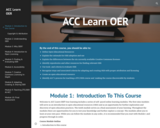
ACC Learn OER is a series of self-paced online learning modules designed specifically for Austin Community College faculty and staff. The first nine modules will serve as an introduction to open educational resources (OER) and as an opportunity for further exploration and discovery of open education practices. The tenth module serves as a final assessment of learning. Throughout the modules there are opportunities to test ones knowledge and further explore a concept. The modules allow one to learn at their own pace. While one can follow the modules in any order, it is recommended to start with Module 1 and progress through in order.
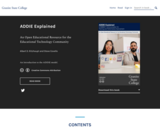
An introduction to the ADDIE model.
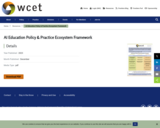
This Framework is adapted by WCET from Cecilia Ka Yuk Chan's 2023 Comprehensive AI Policy Education Framework for University Teaching and Learning. It is free and openly available to anyone. It will complement the forthcoming WCET Artificial Intelligence Toolkit.

Explore the convergence of Generative AI, OER, and Open Pedagogy. Discover strategies for harnessing AI to create and adapt open resources.Session recording from August 21, 2024Run time: 51 minutes

A panel of Texas educators explored the latest innovations and best practices for integrating AI into teaching and learning. Hear from educators on how they are using AI to enhance assignments, projects, and student learning outcomes, as well as the key considerations and strategies for successful AI integration in the classroom.
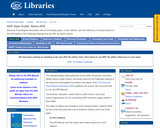
The standard citation style guide book for the fields of business, education, health science, public service, and social science is the Publication Manual of the American Psychological Association, 6th edition, 2010. The American Psychological Association (APA) publishes the manual. We commonly refer to it as "the APA Manual".
The business, education, health science, public service, and social science departments at IRSC recommend APA format for papers written in these fields.
Two types of citations are included in most research papers: citations within the text of the document and a list of reference citations at the end of the paper.
In-Text Citations:
The APA Manual uses the author-date citation system for in-text citations.
Reference Citations:
The sources you use in your work are included as a separate list at the end of the paper. The APA Manual suggests using the title, References, for the list.
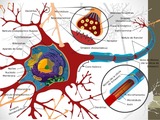
Anatomy and Physiology Lab I slide decks created by Steven Lee M.S. Pathology, FTCC. The PowerPoints include labeled body images to assist students in identifying body parts. Nicole Shaw is only responsible for assisting Steven with licensing his work under an open license and uploading content to the Commons.
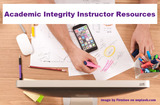
Academic cheating is a growing problem in educational institutions around the world, and it can take many forms, including plagiarism, collusion, and cheating during exams. Academic cheating can have serious consequences for students, educators, and the academic community as a whole.The Academic Integrity Instructor Resource Platform is a growing and evolving online resource designed to support and promote academic integrity among faculty members. This resource serves as a go-to platform for faculty seeking guidance, tools, and best practices to foster a culture of academic honesty and prevent plagiarism and cheating within their online, online-live, hybrid, and face-to-face, classrooms.
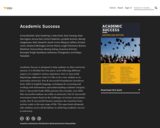
Academic Success is designed to help students on their university journey. It is divided into four parts, each reflecting different aspects of a student’s tertiary experience. Part A: Successful Beginnings addresses what it is like to be a new student at an Australian university. Part B: Successful Foundations introduces basic skills in English language, techniques for accessing and working with information, and understanding academic integrity. Part C: Successful Study Skills presents the everyday, core skills that successful students use while at university. Lastly, Part D: Successful Assessment meets head-on the challenges of tertiary assessments. This open book ultimately aids students across all disciplines in achieving academic success at university.
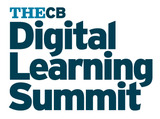
Learn about the TRUE 2023 Grant Program, the Perkins Leadership Grant Program and other developing opportunities for funding that can support innovative workforce teaching and learning projects.
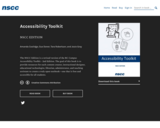
The NSCC Edition is a revised version of the BC Campus Accessibility Toolkit - 2nd Edition. The goal of this book is to provide resources for each content creator, instructional designer, educational technologist, librarian, administrator, and teaching assistant to create a truly open textbook—one that is free and accessible for all students.
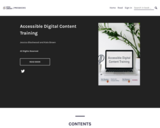
This Pressbook contains video training modules for creating accessible content within digital environments and using content authoring programs, such as the Microsoft Office 365 suite and Pressbooks platform. Each section has an optional self-assessment checkpoint for viewers who wish to check their learning progress. Videos have been migrated to permit open-access.
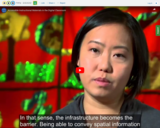
Accessibliity for students with disabilities taking online courses

Activity Sheet: This document provides an overview of how online education helps remove common barriers to accessing education, such as geographical restrictions, disabilities, scheduling conflicts, social stigma, and financial constraints. It uses simple icons and explanations to illustrate how the flexibility and accessibility of online learning platforms can expand educational opportunities to a broader range of students. This would be a useful resource for those exploring online education options, comparing modalities, or looking to increase enrollment through distance learning programs.
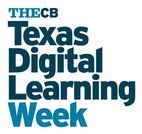
Recording from Texas Digital Learning Week.

The Texas Higher Education Coordinating Board Division of Digital Learning discussed available resources to support agility in adapting to emerging technologies and innovations, with a focus on the Texas landscape of AI adoption and use at institutions of higher education. Session recording from July 17, 2024Run time: 56 mins
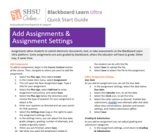
Assignments allow students to submit electronic documents, text, or media in Blackboard Ultra Courses. This walkthrough covers adding assignments to Ultra courses as well as assignment settings and grading.
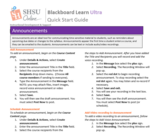
Announcements are an idea tool for communicating time sensitive material to students in Blackboard. This guide covers how announcements are added, scheduled, and posted to Ultra Courses.
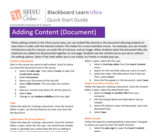
A quick start guide that touches on creating a Blackboard Ultra Document and how content is added to the document.